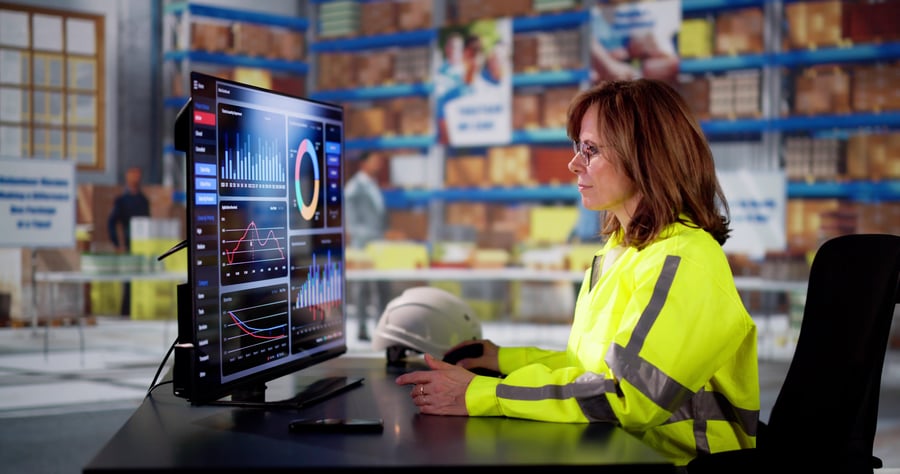With over 15 years of experience in finance, risk management and data analytics, Bill understands exactly what enterprise businesses should be thinking about as they build their corporate growth and risk strategies. Prior to joining Creditsafe in 2021, he spent six years at Dun & Bradstreet as Area Vice President of Finance Solutions and Third-Party Risk & Compliance.
Vendor management is a key part of protecting your business from compliance violations. How strong are your processes?
What makes a brand trustworthy? While some people wait to build up a relationship before deciding they can trust a company, others need less convincing. When actress Jessica Alba founded The Honest Company, for example, many consumers and suppliers trusted her promise that the cleaning products were free of harsh chemicals.
But it was just a few years later that The Honest Company was hit with a lawsuit claiming that its products contained SLS, a skin irritant. Since the company had explicitly promised that its products didn’t contain that chemical, they faced false advertising claims. That year, the company laid off more than 14% of its workforce.
So, what makes this story any different from other ones about celebrity-driven brands? This isn’t a story about false advertising; it’s about vendor management. The Honest Company’s complex supply chain meant it was difficult for them to know for sure whether their products contained chemicals like SLS. If they’d had a more robust and complete vendor management process, they would have been able to identify the issues in their supply chain well before the problems caught up with them.
The good news? The Honest Company overhauled their vendor management processes. After a successful IPO in 2021, they were valued at over $2 billion.
So, how can your business learn from The Honest Company’s successes – and failures? Like most other companies, you rely on vendors to keep your business running smoothly. You may use vendors to buy supplies and materials, to complete production on yoHour own goods, or both. But if your vendor management process is too relaxed or poorly set up, you’ll feel the impact of it right away. And you’ll feel it across multiple areas of your business, which means good vendor management is crucial for the health of your company.
So, let’s talk about vendor management: what it is, how to improve it and issues to look out for.
Understand who you're working with
Enter a company name to view a free business verification report
The Vendor Management Process
Your business almost definitely already works with vendors. You might be thinking that you already know all there is to know about vendor management. After all, your business has great relationships with your vendors. Isn’t that all you need?
Sure, it’s a great start, but vendor management is about more than building relationships and scoring good deals on the materials and services you need. It’s a multi-staged process that starts before anyone is even close to signing a contract and continues for as long as you work with each vendor.
In general, you can divide the vendor management process into five stages:
Screening and evaluation: You may have a lot of options when you’re looking for a vendor. At this stage, you’ll look at a few options in more detail to see who gives you what your business needs. Look at the quality of the product or service with a sample order, for example. You should also investigate things like their customer service, delivery track record, financial strength and customer referrals.
Qualification and pitch: Once you’ve settled on a vendor, they’ll pitch their service and quote a price for your business. But the price is just one small factor – this stage can involve multiple stakeholders. From procurement to finance and everything in between, everyone needs to give the vendor the green light.
Approval: Procurement, finance, sales and other teams may all have to work together here to make sure that everyone is comfortable with the vendor.
Onboarding and purchasing: Now that you’ve selected your vendor, the next step is getting them set up in your system so you can keep track of them.
Monitoring and compliance: The party doesn’t stop after you’ve signed the contract. Continuously monitoring your vendors helps you avoid hefty fines and reputational damage.

You can't afford to take a lax approach to vendor management
Vendor management can feel like a chore. You're already spending money, but now you have homework on top of that? Yes, yes you do. Just think about how dangerous it can be if you let your vendor management processes fall to the wayside.
One of the areas of vendor management where that especially rings true is compliance. Not only can you face reputational damage if you’re caught working with an unethical vendor, but it can impact your bottom line, too. In 2023, US Customs and Border Protection seized 1,053 shipments of solar energy equipment because they suspected they’d been produced using forced labor. It was the biggest seizure of its kind since the Uyghur Forced Labor Protection Act went into effect. The companies impacted by the seizures had to deal with the disruption to their supply chain and the loss of their materials. On top of that, they were also on the hook for the storage fees while their shipments were, “stuck in limbo with no end in sight,” according to the American Clean Power Association.
6 tips to improve your vendor management process
1. Vet vendors in advance
Every layer of vendor management is important, but this one might be the most valuable. Think about it: when your vendor screening process is robust and complete, you’ll be able to spot problems with potential vendors before you start working with them. That way, you can weed out any unreliable or problematic vendors and only work with companies that’ll help you step up your own game.
When you’re considering a new vendor, start by taking a look at their business credit report. Sure, you aren’t extending credit to your vendor. But you want to make sure their finances are in healthy shape, and they won’t run out of cash mid-way through producing your goods or completing services you’ve hired them for. By looking at your supplier’s business credit report, you can get a clear picture of that business as a whole and see how long they take to pay their bills, how many of their bills are current vs. past due, if they have legal filings against them and if any of their officers have been flagged for corrupt and unethical practices.
But don’t assume that everything’s good to go after you’ve looked at your vendor’s business credit report. If you don’t spot any major red flags, that’s great, but it’s not where the story should end. Remember that you’re responsible for adhering to compliance laws throughout your entire supply chain. That means if any of your companies are in violation of local laws, or they work with any sanctioned entities, you’ll be the one fined. And you probably want to avoid that, right?

Take your screening up a notch by introducing Know Your Company (KYC) and compliance checks at the early stages of your vendor management process. It might sound like a lot of work to go that extra mile before you’re even sure whether you want to work with a vendor. But it’s worth it, trust me. Plus, if you use compliance software that can run quick and reliable checks against OFAC and other compliance databases, you’ll have a source of data you can rely on. From there, setting up monitoring alerts will help you watch all your vendors without wasting time with manual checks. If something changes, you’ll know right away.
2. Create a robust framework for vendor evaluation
Once the deal has been approved by all the stakeholders you need a yes from, you’re now in business together. From here on out, your vendor is responsible for providing whatever product or service your company is buying. But that doesn’t mean you don’t have responsibilities too.
Bill James, Enterprise Sales & Strategy Director for Creditsafe, says “Before anything else, you need a basic onboarding checklist. Ask yourself: What do I need from these vendors in every single case? It could be anywhere from a couple dozen to hundreds of questions, depending on how comprehensive you’re being. And once you have that checklist, you can move into automation.”
For example, most manufacturing companies offshore at least some of their production. According to our study The Murky Waters of Overseas Manufacturing, for example, 64% of North American manufacturing companies use suppliers in Asia. One of the most important parts of the vendor management process when your vendors are located overseas is compliance. You need to become an expert (or at least hire someone who is) at navigating the laws in each country your vendors are from. Remember: if you don’t catch vendor compliance violations, it’s you that ends up paying the price.
3. Continually monitor your vendors
The easiest way to avoid issues down the road with your vendors is to make vendor monitoring part of your regular workflow. In our study The Murky Waters of Overseas Manufacturing, 22% of companies said they don’t currently have compliance due diligence policies and procedures in place.
Think about it this way. You should already be monitoring your customers and their financial health. How else will you be able to predict which customers are most likely to pay you back late? You should be doing the same with your vendors.
Not continuously monitoring your vendors can lead to so many problems. But let’s just consider a couple - we don’t have all day, after all. Let’s say you’re a manufacturing company relying on an overseas vendor to produce the bulk of your children’s toys for the upcoming holiday season. If you aren’t keeping an eye on the vendor’s business credit report, you could miss obvious red flags indicating they’re on the verge of running out of cash and won’t be able to fulfill your order. That kind of disruption in your supply chain would completely flip your holiday production – and sales – upside down.

And it’s not all about financial health, either. Continuous vendor monitoring means you’ll avoid working with sanctioned companies, or companies violating local laws. We’ve already talked about what that kind of thing can do to your bottom line (but if you need a reminder, it’s not good). And if you’re caught working with a vendor using child labor, for example, you run the risk of severe reputational damage, too. In January of this year, Starbucks was sued by a consumer advocacy group for working with “abusive and unsafe” suppliers. This flew in the face of the brand’s advertised dedication to sustainability (not to mention supplier compliance laws), so Starbucks had to act quickly. They released a statement saying they would “take immediate action” and “ensure corrective action” occurred. While it’s great that Starbucks was able to fix their vendor issues, maybe they could have avoided them in the first place if their vendor management process was able to spot risks more effectively.
4. Collaborate to review and approve the vendor list
You’ve done all the right things: screened your potential vendor, qualified them and spoken to a sales rep to figure out the potential terms. You’re good to go now, right? Not so fast.
Just because one team in your business thinks a vendor is a good choice, that doesn’t mean there aren’t other risks the vendor could pose. You need to have multiple departments and stakeholders review your list of vendors and make sure they meet all the criteria to minimize risks.
In our study, The Sales vs. Credit Control Battle, 47% of sales professionals revealed they have up to 10 deals rejected each month by their finance team. An additional 56% said their deals were rejected “often” or “sometimes.”
Getting the entire company up to speed with your compliance and financial processes can be a game changer when it comes to getting more vendor deals approved. If everyone knows what to look for, or if everyone is working with the same decisioning software, everyone is on the same page about what you’re looking for in a vendor. From there, it’s much easier to identify when a vendor is the right fit – or the wrong fit.
5. Make vendor management a group effort
The bottom line is, even if you aren’t directly responsible for vendor management, the impact of poor vendor management can still affect your team. A great way to strengthen your vendor management process is to try to fill all the gaps that can appear throughout the vendor management process. The best way to do that? Get everybody on board.
Your vendor management process should include the following teams within your business:
Finance: We’ve touched on this already, but your finance team is key to the vendor management process. Since they often have final approval about whether your company works with a vendor, they need access to all the information so they can make an informed decision.
Operations: Your operations team is probably already heavily involved in the vendor management process. The issue is, if your operations team is using a different source of data than your finance team, they could make decisions that might make sense from an operational perspective but could lead to financial trouble down the line.
Procurement: Supply chain procurement is a complicated process. Thankfully, it goes hand in hand with vendor management. Procurement is all about sourcing the right materials for your business. That means your procurement team must know your vendor management and compliance policies. They should be kept in the loop of the process and understand the signs – both good and bad – to look out for.
IT: Vendor management gets a lot easier when you use the right software. If your IT team understands the company’s vendor management needs, they can help choose the best tech for the job. Include them in the process and they can vet your technology. How secure is it? How many people can use it at once and what kinds of things can they do with it? Can it be fully integrated into your existing workflows?

6. Use KYC software
KYC, or Know Your Customer, is part of the vendor onboarding process. Before you work with a new vendor, you need to make sure you know who you’re working with. Not only does this keep a record of who you work with and for what, it protects your company in other ways, too. KYC checks make sure you aren’t doing business with vendors engaged in unethical practices, like fraud and money laundering. Good KYC software protects your business from compliance violations, but great KYC software also helps you onboard vendors faster and foster greater trust between your company. Integrated KYC software helps you quickly run checks on potential vendors before you decide whether to work with them. From there, you can make smarter, safer choices for your business.

About the Author
Bill James
